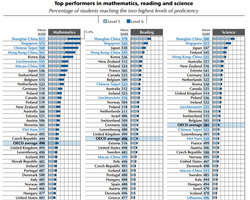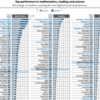http://lucidwitness.com/2015/0...data-or-life-data-2/
What should be included in “Balanced Report Cards” about schools?
Is understanding the whole child important for teaching and learning ?
How do we appropriately interpret a child’s academic data, produced while at a school desk ?
Can we ever understand academics in a vacuum ?
Professor Deborah Duncan Owens’ argues for more than academic “tunnel vision” about student results and outlines international perspective in her recent posted discussion (highlighted here) :
“The OECD, the organization that brought us PISA scores which for critics of public schools act as the bellwether for school success, recognizes that the well being of children encompasses more than test scores and, therefore, publishes rankings on material well-being, housing and environment, health and safety, risk behavior, educational well-being, and quality of school life. Of course, systemic educational reformers in the U.S. only want to focus on data from standardized test scores.”
My perspective from the front line with trauma-impacted children, is that Duncan Owens is right on target: we ignore, or assume away other factors at our own loss of understanding.
Our ignorance or our silence is unfathomable in the face of the epidemic of childhood trauma. See “Danny Goes to School“. Our own DOJ report describes it as a “crisis”.
PISA 2012 academic results (only), below, for those “systemic educational reformers” who focus solely on the academic silo:

COMPLETE ORIGINAL POST: DUNCAN OWENS

In my last post I suggested that if the government is so intent on publishing standardized testing data as an indicator of the effectiveness of teachers and schools, they should likewise publish other meaningful data on the communities teachers and schools serve. In What’s Missing in Education “Reform” ? Daun Kauffman discusses another dimension of child wellbeing that is distinctly missing from discussions of education reform. One dimension that is missing, according to Kauffman, is “the massive incidence of childhood trauma, and its laser-like connection to cognition and education ….” Children who live in urban settings typically experience more incidents of trauma.
A great deal of research has been generated about the impact of childhood trauma or “Adverse Childhood Experience” (ACE). Therefore, Kauffman makes the following suggested addition to the data that should be reported concomitantly with standardized test scores:
“What are the aggregated, community rates of Childhood Trauma, or “Adverse Childhood Experience” (ACE), as separate from ‘poverty’?” What are the reported incidents within a community of physical abuse, sexual abuse, emotional abuse, and physical or emotional neglect? How many children are being raised in single parent homes due to abandonment, separation, divorce, or incarceration? What are the reported incidents of household violence, substance abuse, and mental illness?
I agree with Daun Kauffman that this type of data is clearly missing in discussions of child wellbeing. The federal government funds research in the area of childhood trauma/ACE and, therefore, it would seem that the government acknowledges the impact of trauma on a child’s ability to meet the cognitive demands of school life. According to Kauffman:
“ACE Rates vary widely. Chronic exposure to ACEs directly affects cognition. They have the power, as chronic events, to disrupt neurodevelopment and secondarily social behavior(as defenses against the onslaught). Presently ACEs are ignored in educational performance analyses. Ignored at macro levels, ignored at District level, ignored at school level . . . Their prevalence is shocking: suburban rates (for 3+ ACEs) have been measured at 22% and urban rates at 37% and greater. A prevalence above the COMBINED rates of ELL and IEP students.”
It is not without irony that education reformers posit that improvement in the academic lives of children begins and ends at the schoolhouse door and they distance themselves from meaningful data about the realities of the lives of too many children through “no excuse” rhetoric that teachers can demonstrate academic improvement for every student regardless of all the factors that impact their lives. No other profession is held to the same level of accountability, responsible for one narrow set of outcomes in spite of all other dimensions of human life.
Again, if the federal government is so intent on public disclosure of standardized test scores as an indicator of the effectiveness of teachers and schools, they should be required to provide a full picture of the data that impacts the lives of children. Then, perhaps, teachers will get the credit for their noble efforts in trying to educate children who face almost insurmountable challenges every day. As one teacher I interviewed a few years ago poignantly stated about her young students in a high poverty community, “I’m trying to teach these children to read and they’re trying to survive.” I’ve experienced firsthand the devastating impact of unsafe communities on the lives of children. I’ve heard children speak of family members murdered, imprisoned, and lives lost to drugs and crime. I saw little children take freshly sharpened pencils and pretend to inject themselves in the tiny little crooks of their arms. It broke my heart.
How dare education policy makers ignore the realities of the lives of far too many children in the U.S. when they boldly and callously propose systems for holding teachers accountable for academic performance while ignoring the devastation of too many of the communities that create the world children have to navigate through on the way to and from school? Children deserve better.
For more information, see:
http://lucidwitness.com/2014/09/25/whats-missing-3/
http://www.cdc.gov/violenceprevention/acestudy/
http://captus.samhsa.gov/preve...ldhood-experiences/1
http://www.cdc.gov/ncipc/pub-r...Childhood_Stress.pdf
http://www.whealth.com.au/docu...LiteratureReview.pdf
Thank you Professor Duncan Owens.





Comments (2)